AQUA Wallet Review 2024: A Bitcoin, Lightning and Liquid Software Wallet
In this review we analyze AQUA Wallet: a mobile-only wallet for Bitcoin. Easily manage, send, receive, and swap Bitcoin on Lightning and Liquid Assets. Perfect for casual or new users seeking simplicity in their digital currency journey.
Occasionally, a product emerges that effectively addresses a specific issue precisely when needed, and I am convinced that the AQUA Wallet fits this description perfectly.
However, what does it specifically offer, and why should you consider installing it? With numerous existing non-custodial hot wallets already available, what sets AQUA Wallet apart?
In this review, we will delve into the features of AQUA Wallet, a Bitcoin wallet that distinguishes itself through its commitment to seamless integration and user-friendly interface with Bitcoin's prominent layer 2 solutions, including the Lightning Network and the Liquid Network.
| DESCRIPTION | DETAILS |
|---|---|
| 💻 Name | AQUA Wallet |
| 🌐 Website | aquawallet.io |
| 🗓 Release year | 2024 |
| 💰 Coins Supported | Bitcoin (Bitcoin Network, Lightning Network, Liquid Network), Liquid Assets |
| 💸 Price | Free |
| 🔒 Security Features | BIP39 12 words seedphrase backup |
| 💻 Compatibility | Android, iOS |
| 🔄 Connectivity | N/A |
| 📜 Software License | Open Source, MIT License |
What Is AQUA Wallet

It's a relaunched version of the initial AQUA wallet app introduced by Blockstream in September 2020. However, it was somewhat neglected as the company shifted its focus to projects like Blockstream Green. Nearly four years later, AQUA has been relaunched by JAN3, a bitcoin-centric company led by the ex-Blockstream exec and renowned figure in the Bitcoin community, Samson Mow.
AQUA Wallet, works as a non-custodial Bitcoin hot wallet, extends beyond the main Bitcoin chain by providing support for additional layers in a user-friendly manner.
It perfectly aligns with the average user preferences for a daily spending wallet. Whether receiving funds on the main chain, Lightning Network, or Liquid, AQUA Wallet ensures seamless transactions. The native SideSwap feature facilitates easy swapping from the main chain to second layer coins and vice versa.
Additionally, incoming Lightning Network transactions are automatically swapped to Liquid, while outgoing Lightning Network transactions seamlessly convert from Liquid.
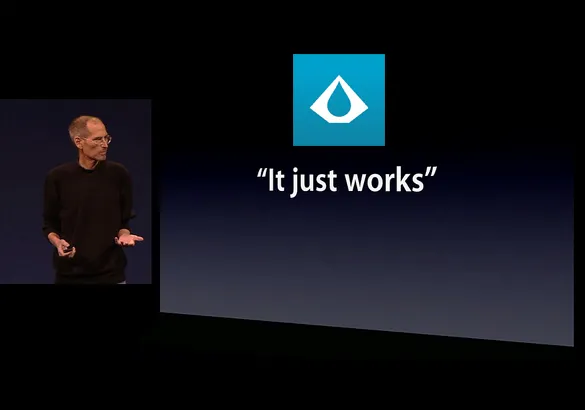
Main Features
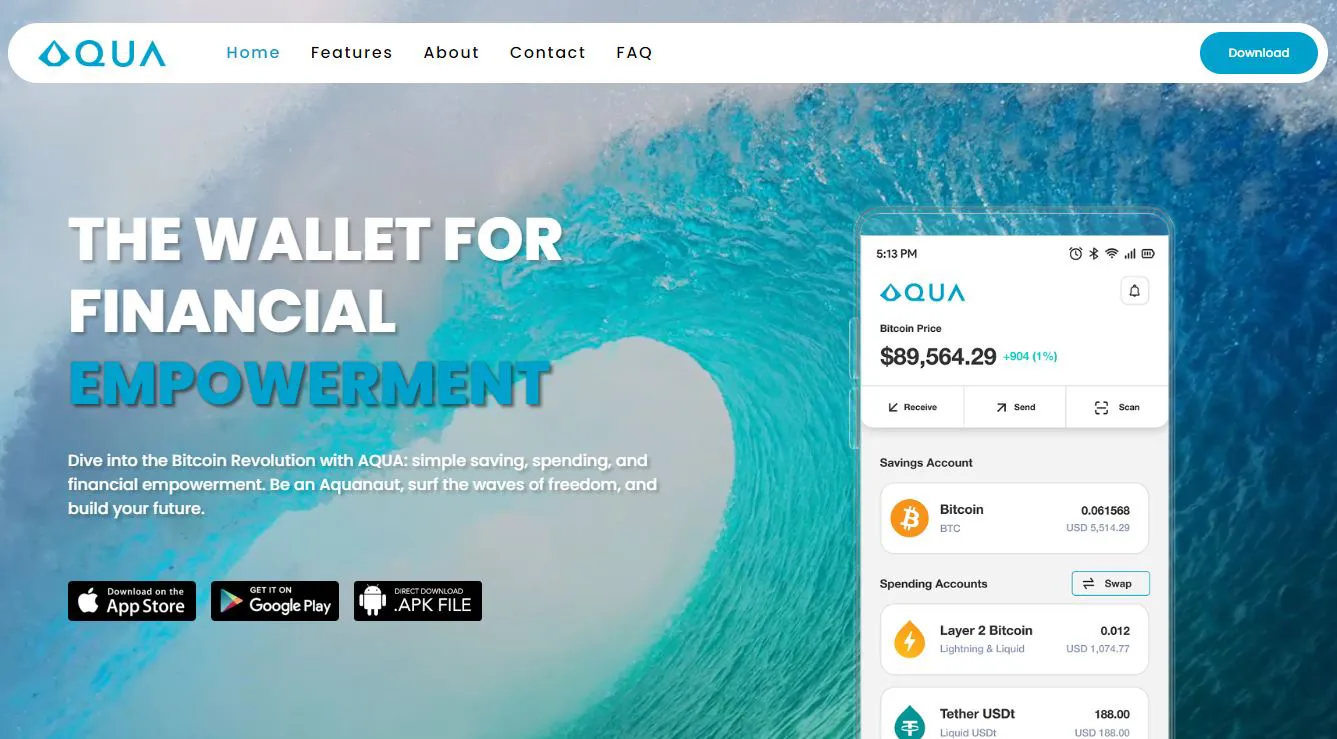
While AQUA Wallet may appear straightforward at first glance, its functionality goes far beyond simplicity, offering a plethora of features that prove incredibly advantageous from an economic perspective.
The standout quality of this wallet lies in its emphasis on affordability and convenience, achieved through the implementation of Bitcoin sidechains like Liquid, known for its high anonymity and cost-effectiveness. Let's delve into the key features that make AQUA Wallet a robust choice in the realm of cryptocurrency.
An All-in-One Bitcoin Wallet
With AQUA, managing your Bitcoin becomes a seamless experience. Hold, swap, and transact with ease, enjoying convenient access to Lightning and the Liquid Network. AQUA serves as a unified platform for navigating the diverse layers of the Bitcoin blockchain. AQUA it's a wallet that effortlessly facilitates transactions in Bitcoin, Lightning, and Liquid assets, including Tether USDt.
Complete Control
Rooted in the principle of self-sovereignty, AQUA is a non-custodial wallet, ensuring that you retain ownership of your keys and maintain full control over your assets. Your financial autonomy is a top priority.
Access Dollars with Ultra-Low Fees
AQUA's focus on the power of the US Dollar delivers stability and accessibility to users, particularly in Latin America. Benefit from cost-effective transactions as AQUA provides a reliable gateway to the US Dollar.
Receive and Send USDT Tether, No Gas Needed for Fees
As a native stablecoin wallet, AQUA eliminates the necessity of holding an altcoin. Pay seamlessly with your Liquid Bitcoin or, in the near future, directly from your Tether balance without worrying about gas fees.
The Cheapest and Most Private Stablecoin Transfers
Experience the affordability of sending dollars anywhere with AQUA. Leveraging USDt Tether and the Liquid Network, AQUA offers the advantage of low-cost and private stablecoin transfers.
Buy Bitcoin and Access a Range of Services (Coming Soon)
Explore AQUA's built-in Marketplace, allowing you to buy bitcoin from diverse sources. Stay tuned for upcoming services, including peer-to-peer loans, a VISA debit card, and interest-bearing products, set to be introduced in new countries and regions.
Send and Receive from Other Chains
AQUA facilitates the acceptance of payments from other chains, such as Ethereum or TRON, without the risk of holding them. Receive these funds seamlessly as USDt, expanding the scope of your financial interactions.
Quick AQUA Wallet Review
Perhaps our blockdyor Score could use some adjustments when evaluating software wallets, it remains evident that AQUA Wallet stands as a reliable option. However, it's important to acknowledge that, being a software wallet, it cannot match the security levels offered by hardware wallets.
Ultimately, AQUA Wallet belongs to the category of hot wallets, emphasizing the need for users to weigh the convenience of software wallets against the enhanced security features provided by hardware alternatives.
| Category | Feature | Score |
|---|---|---|
| 🔐 Privacy & Security (34/50) | ||
| 📄 Open Source Compliance | Source code is publicly available and is Open Source | 10/10 |
| 🔄 Firmware Integrity | Firmware can be built from source and binaries match | 10/10 |
| 🔐 Security | The wallet is non custodial but it doesn't have any PIN or Face ID security. No TOR support either | 4/5 |
| 🌱 Seed Generation | The method and entropy used to generate the seed based on the Green Development Kit (GDK) | 3/5 |
| 💾 Seed Storage | Is unknown how or where the seed is stored | 1/5 |
| 💼 Hardware Wallet | There are no integrations with hardware wallets | 1/5 |
| 💰 Purchase Procedure | The app is free of charge | 5/5 |
| 💸 Fees | Aqua Wallet fees are low | 5/5 |
| 🚀 Features (27/50) | ||
| 🖥️ User-Friendly UX | Easy to read and use thanks to the intuitive UX, but iOS has less functions than Android | 5/5 |
| 🎨 Design | The early version we tested needs some polishing | 3/5 |
| 📡 Air Gap / PSBT / SeedQR | Doesn't support any airgapped configuration | 1/5 |
| 💾 MicroSD Backup | Cannot be backed up & restored on microSD | 1/5 |
| 🤝 Multisignature Support | Doesn't Support Multisig wallets | 1/5 |
| 🔐 Passphrase (BIP39) | Doesn't support BIP39 Passphrases (13th or 25th word) | 1/5 |
| 🔌 Connection | It doesn't have any external connection | 1/5 |
| 📦 Ready-to-Use | Comes with everything needed to start immediately | 5/5 |
| 📚 Documentation | Detailed user guides available online | 5/5 |
| 🛠️ Customer Support | Company offers customer support | 5/5 |
| 🧱blockdyor Score (61/100) |
How Does The Aqua Wallet Works?
AQUA Wallet goes beyond the conventional approach of software wallets, redefining the landscape by not only storing funds in a non-custodial manner on the blockchain but also leveraging the power and cost-effectiveness of Bitcoin's second-layer chains, such as Liquid and Lightning, for daily spending.
The wallet allows users to receive on-chain, through Lightning, or via Liquid, with native Side Swap functionality for swapping from on-chain transactions. Incoming Lightning transactions are automatically swapped to Liquid, and outgoing Lightning transactions seamlessly convert from Liquid.
In my perspective, AQUA Wallet serves as an excellent daily driver for managing Bitcoin holdings, receiving altcoins, and automating conversions to USDT or Bitcoin across various layers. It facilitates accumulating Bitcoin in different layers and allows easy swapping when needed, streamlining the process of moving funds to cold storage without creating unnecessary small UTXOs, opting for a consolidated, larger one.
AQUA effectively addresses the high fees that have historically burdened Bitcoin users, providing users with the freedom to receive, send, accumulate Bitcoin in various ways, and swap it as desired.
Within AQUA, users can have several distinct types of wallets:
Bitcoin Wallet
This non-custodial wallet supports full SegWit addresses (starting with bc1...), optimizing fee reduction. While it lacks the capability to connect to a personal node, users can choose between the default minimalistic Blockstream.info explorer and the more feature-rich Mempool.space.
Lightning Wallet
This wallet allows instant receiving without the need to open a channel. Operating under the Layer 2 Bitcoin section, it shares similarities with Zeus wallet's approach of opening a zero-confirmation channel.
The Lightning wallet is fully non-custodial. Currently, only invoice generation is possible, with no option to set a Lightning Address.
Aqua initiates its operations by harnessing the synergies between the Lightning Network and the Liquid sidechain, creating a platform for efficient and trustless cross-chain submarine swaps. This capability proves especially valuable in the present high on-chain fee environment, driven by the increased demand for innovative Bitcoin-based features like Ordinals, BRC-20 tokens, and Stamps.
Within this interconnected framework, Aqua allows users to seamlessly manage Lightning channels by opening, closing, and funding them through an integration with Boltz, all at a reduced cost. This not only amplifies transaction efficiency but also significantly alleviates the challenges posed by the current fee landscape. In times of heightened demand for Bitcoin-related innovations, where conducting on-chain transactions might be economically impractical, Aqua ensures that the Bitcoin network remains accessible and user-friendly.
Liquid Bitcoin Wallet
Leveraging the popularity of Liquid, a Bitcoin sidechain known for its quick block speeds and lower fees compared to the main Bitcoin chain, this wallet offers straightforward sending and receiving capabilities. It is located under the Layer 2 Bitcoin section.
USDt Wallet
Aqua Wallet features a built-in Tether USDt wallet, supporting three major blockchains - Liquid Network, Ethereum Network, and Tron Network.
Each network offers unique features, such as native receiving with no minimum amount on Liquid Network, on-the-fly conversion from Ethereum USDt to Liquid USDt, and a similar setup on the Tron Network.
In summary, AQUA Wallet provides a comprehensive and innovative solution for Bitcoin and stablecoin management across various layers, offering users unprecedented control and convenience in their cryptocurrency transactions.
How To Set Up AQUA Wallet
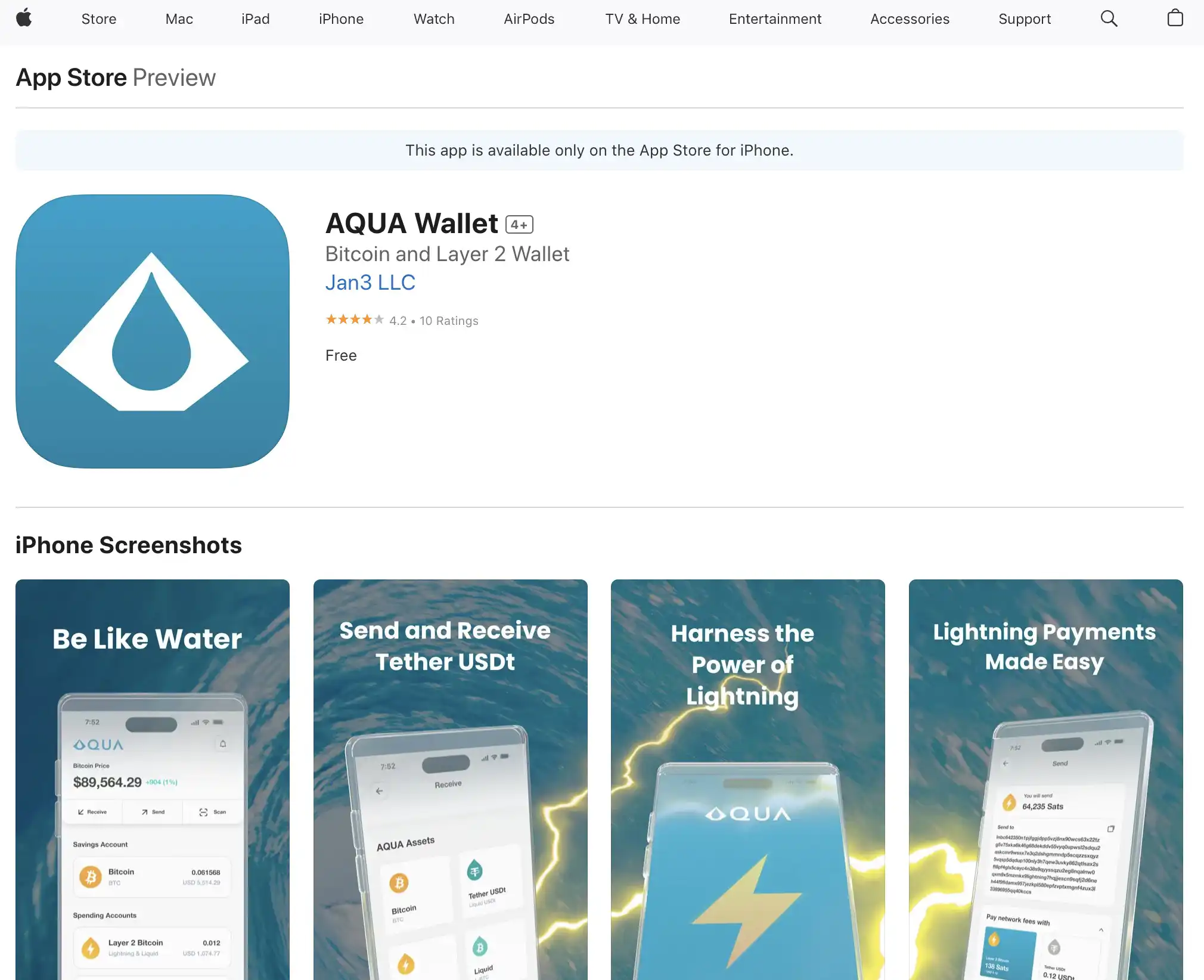
To begin using AQUA Wallet, simply download the app, which is freely accessible on both Android and iOS through their respective app stores. Additionally, for those preferring an open-source option, AQUA Wallet is also available on F-Droid.
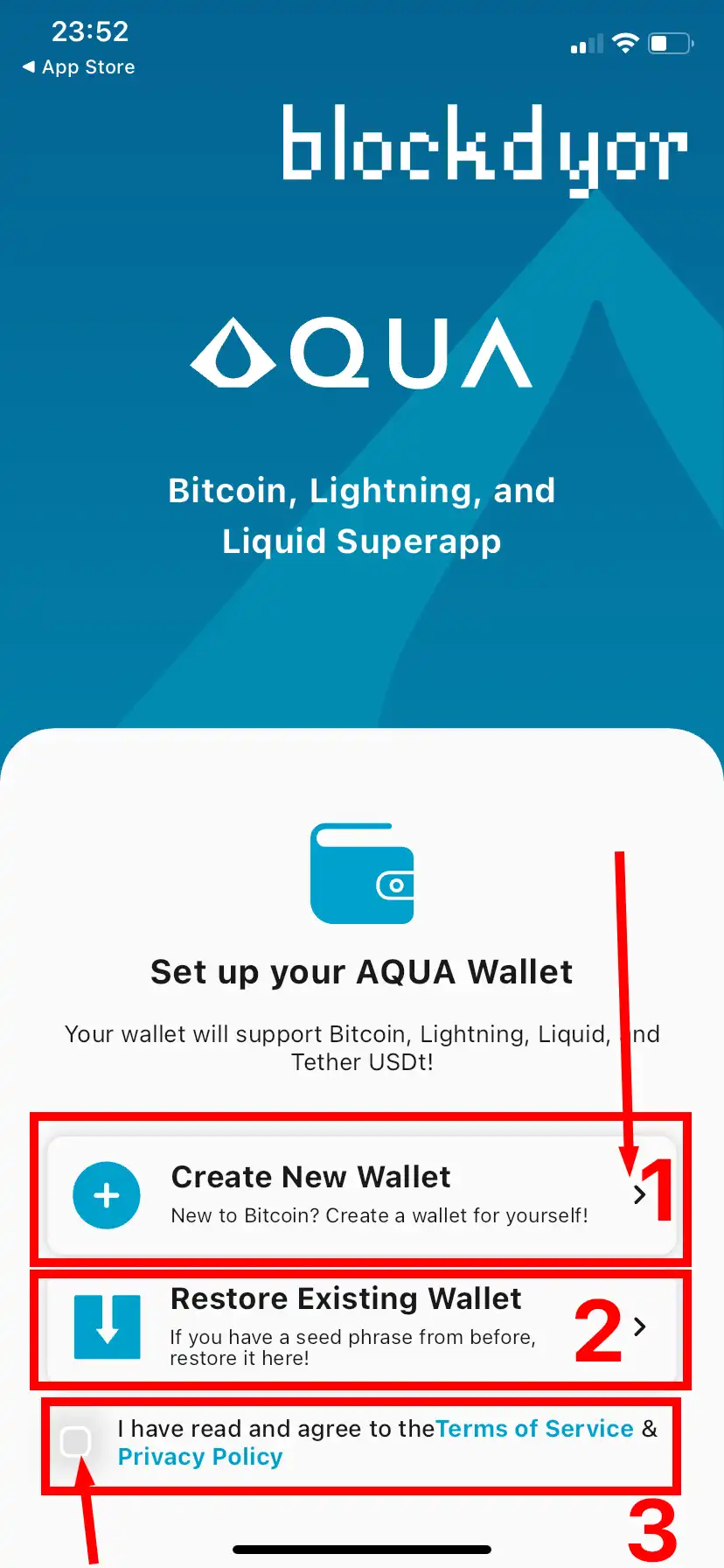
Upon launching the app, you will encounter a prompt to toggle the box for accepting the terms and conditions of the application (3). At this point, you can choose to either initiate the setup by restoring a wallet (2) or creating a new one (1).
Opting to create a new wallet will prompt AQUA to generate a 12-word mnemonic phrase. This mnemonic phrase serves as the key to accessing your funds across various Bitcoin main chains, sidechains, and even altcoins on the Liquid Network (liquid assets). If you change your phone or just delete the app, you can recover your funds thanks to this seed phrase.
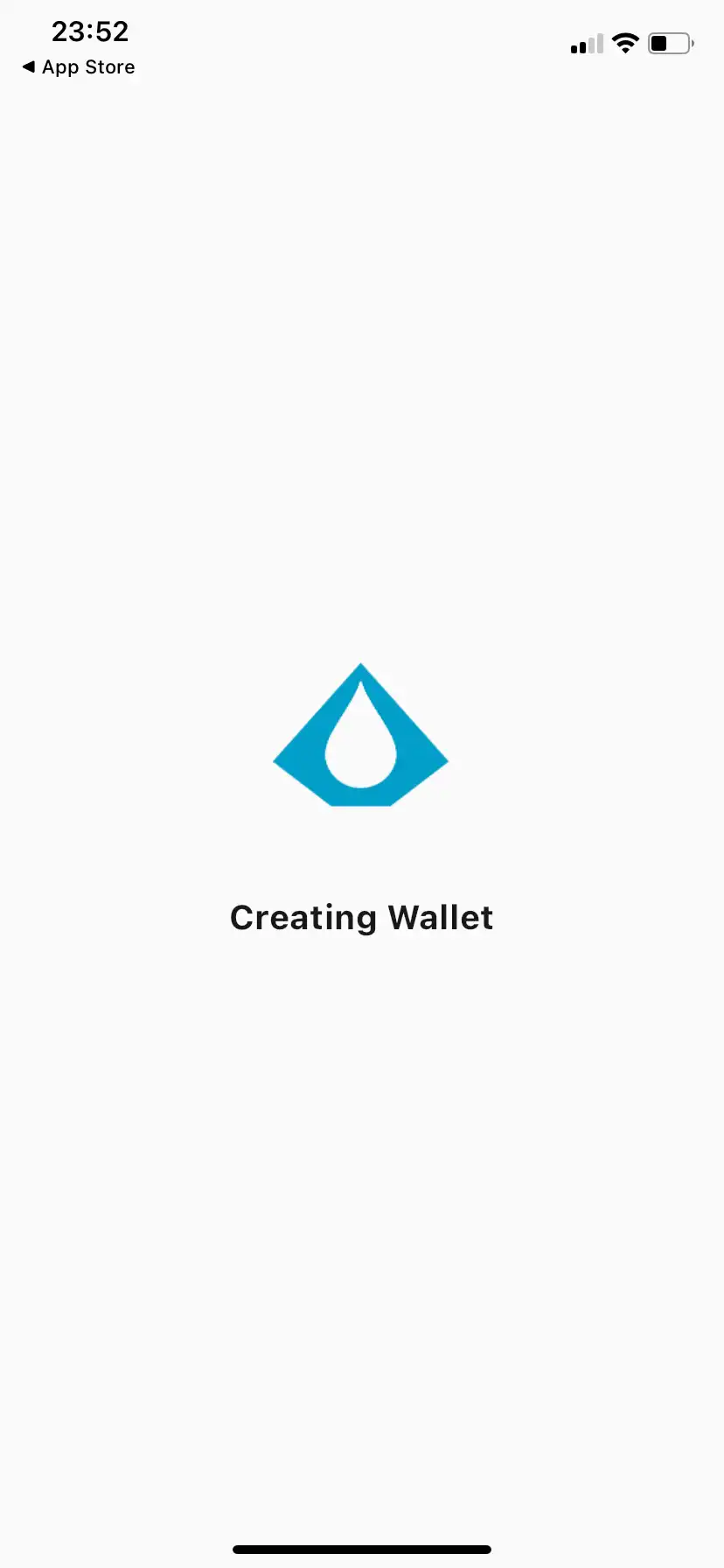
In a few seconds the wallet will be generated and the dashboard will load up.
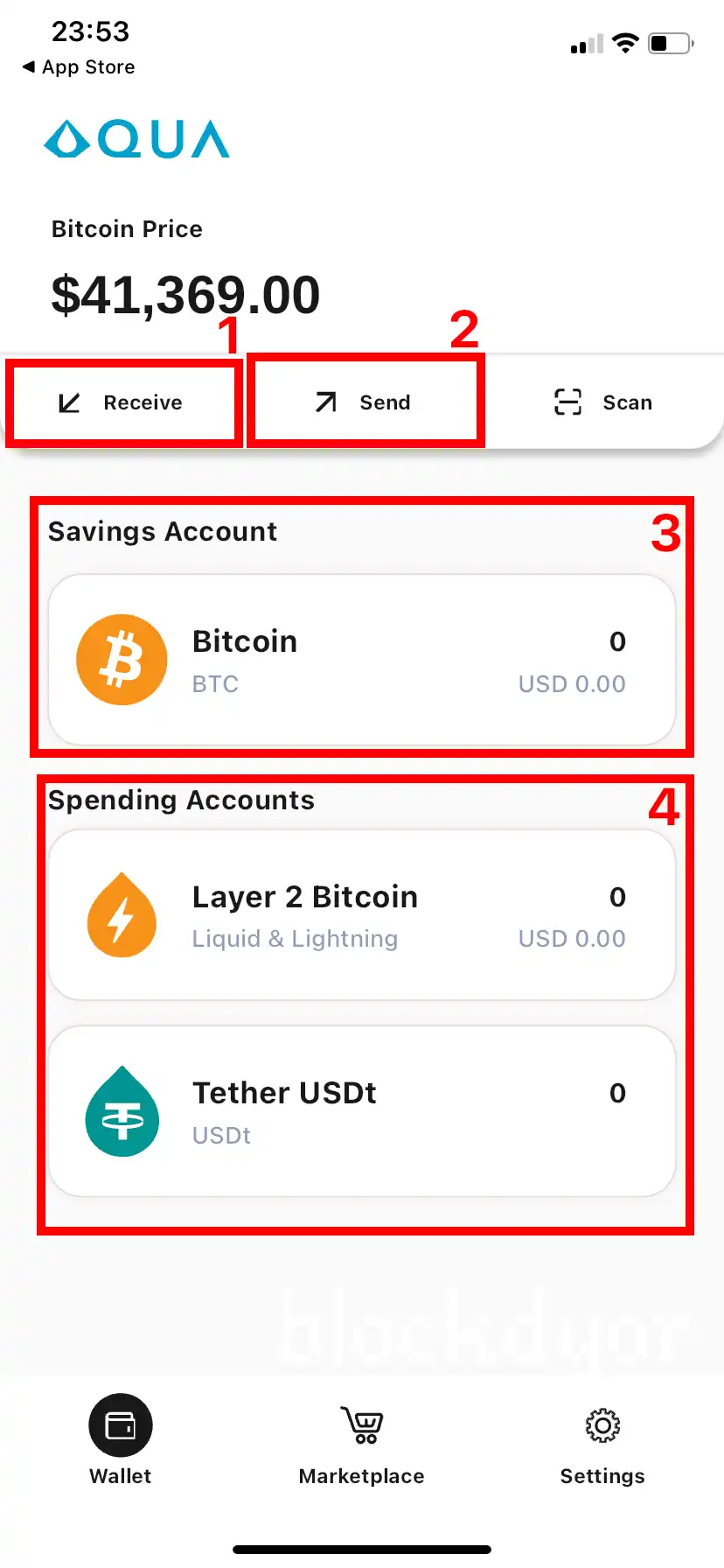
With everything set up, your private key is now generated and can be located in the settings. Aqua even prompts you to note it down during the setup process and later as well. As the dashboard loads, you'll notice the buttons to send (2) and receive funds (1), but also the two key components that I find somewhat revolutionary in this wallet: the accounts.
- Savings Account (3): This represents the Bitcoin main chain, offering a secure storage option for your BTC over the long term. It serves as a wallet where you can store your Bitcoin and maintain ownership of your private keys.
- Spending Accounts (4): Recognizing that the main chain often incurs high fees and is impractical for small transactions, Aqua introduces a "spending" account that incorporates layer 2 solutions such as the Lightning Network and Liquid Network. This Layer 2 account encompasses both the Lightning Network and the Liquid Network. However, Aqua is not a Lightning wallet in the traditional sense, although you have the ability to generate Lightning Invoices and send funds to Lightning addresses, Aqua doesn't directly enable the instant sending and receiving of payments. Instead, it consistently engages in swaps with Liquid.
Sending/Receiving Funds with the Aqua Wallet
Engaging in transactions with Aqua proves to be an exceptional experience, as this wallet not only supports Bitcoin on the main chain, its crucial layer 2 (Lightning), and sidechain (Liquid), but also supports altcoins on various networks. Seamlessly sending and receiving funds is possible across all these networks.
Prior to starting a fund transfer, it's necessary to first receive some. To start this process, click on the Receive button.
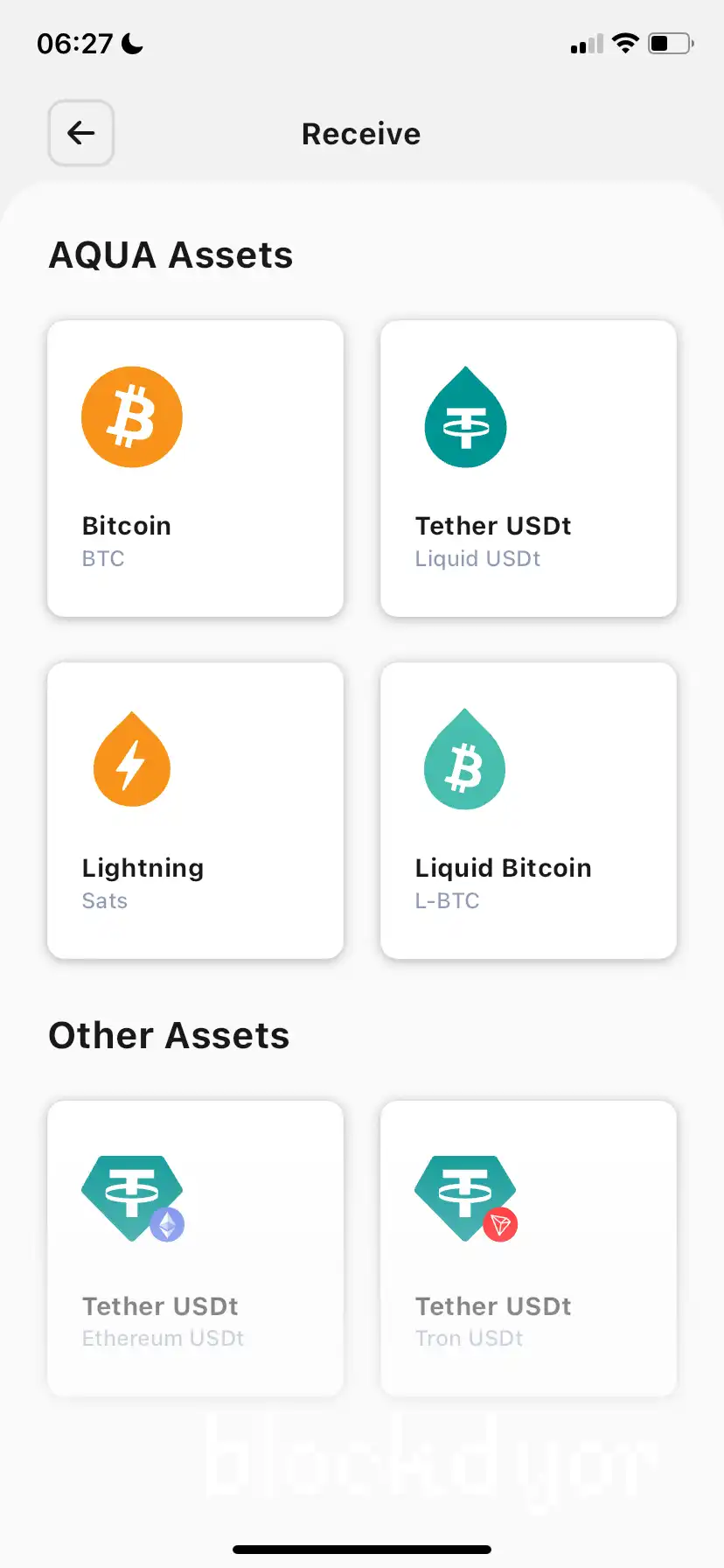
Upon clicking, a view displaying all supported assets will be shown. You have the flexibility to select from these options and even perform swaps later. In my view, the optimal approach, especially for receiving small amounts of funds, would be to utilize the layer 2 solutions.
Later, you can swap these in a consolidated Unspent Transaction Output (UTXO) for the Bitcoin main chain (BTC) and send to your hardware wallet, particularly if cold storage aligns with your preferences.
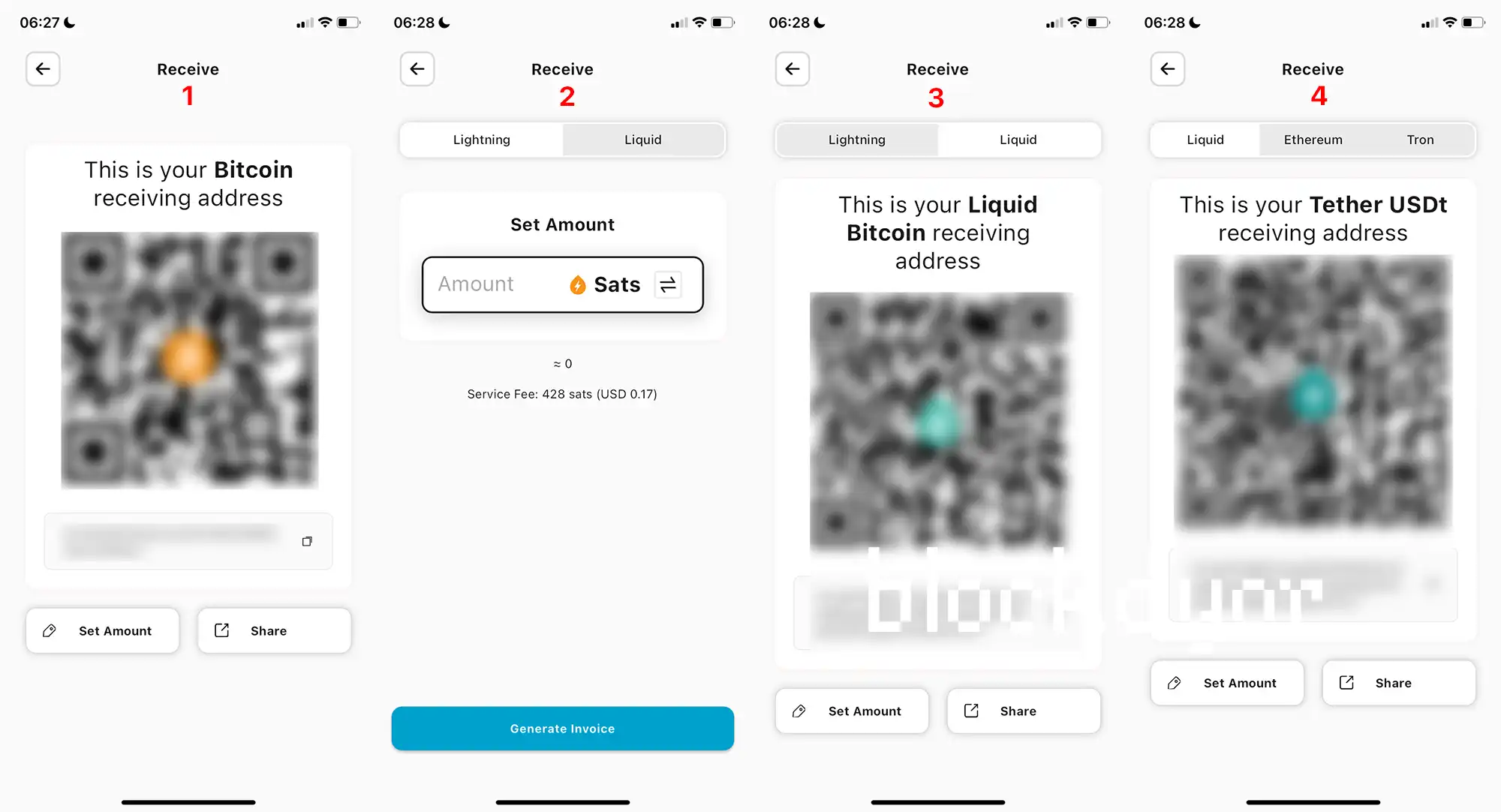
Each of these buttons will unveil the corresponding receiving address based on the selected network:
- Bitcoin: This corresponds to the Bitcoin main chain. Simply scan the provided QR code or copy the receiving address. It's a straightforward and secure method, though potentially more expensive if mempool fees are high.
- Lightning: Generating an invoice with the desired amount is necessary for this option, making it a bit more complex. There is a service fee of a few cents associated with this method.
- Liquid: Arguably the most cost-effective and speedy option. You only need to scan a QR code or copy the receiving address.
- Other networks: Aqua also supports stablecoins and other coins on different networks, such as USDt on Tron or Ethereum. You can receive these using Aqua by selecting this option.
Swapping Assets With The Aqua Wallet
The Swap functionality stands out as one of the most intriguing features within the AQUA wallet, allowing users to seamlessly swap their Bitcoin across various networks without the need for KYC.
This capability is facilitated through the integration of Sideswap within the AQUA wallet, enabling one-click asset swaps. To demonstrate how this feature operates, I will delve into its functionality in the following section.
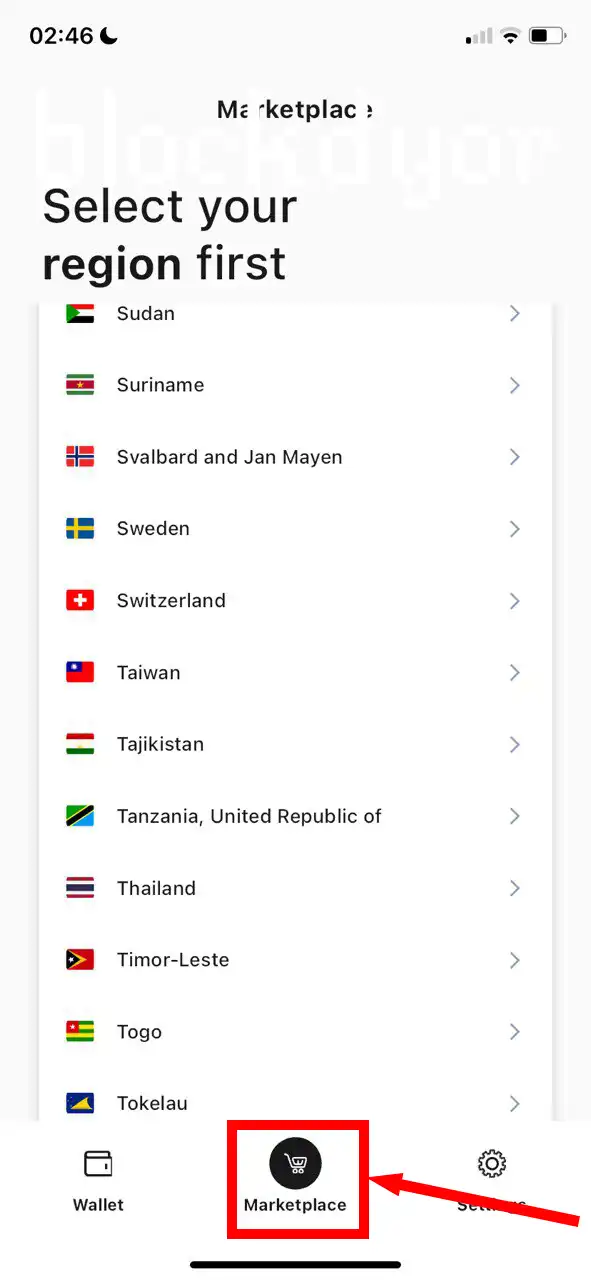
Tap on the "Marketplace" icon located in the bottom menu bar and proceed to choose your nation or residence. It's worth noting that you aren't forced to select your actual nation, given that the Swap KYC process is non-existent.
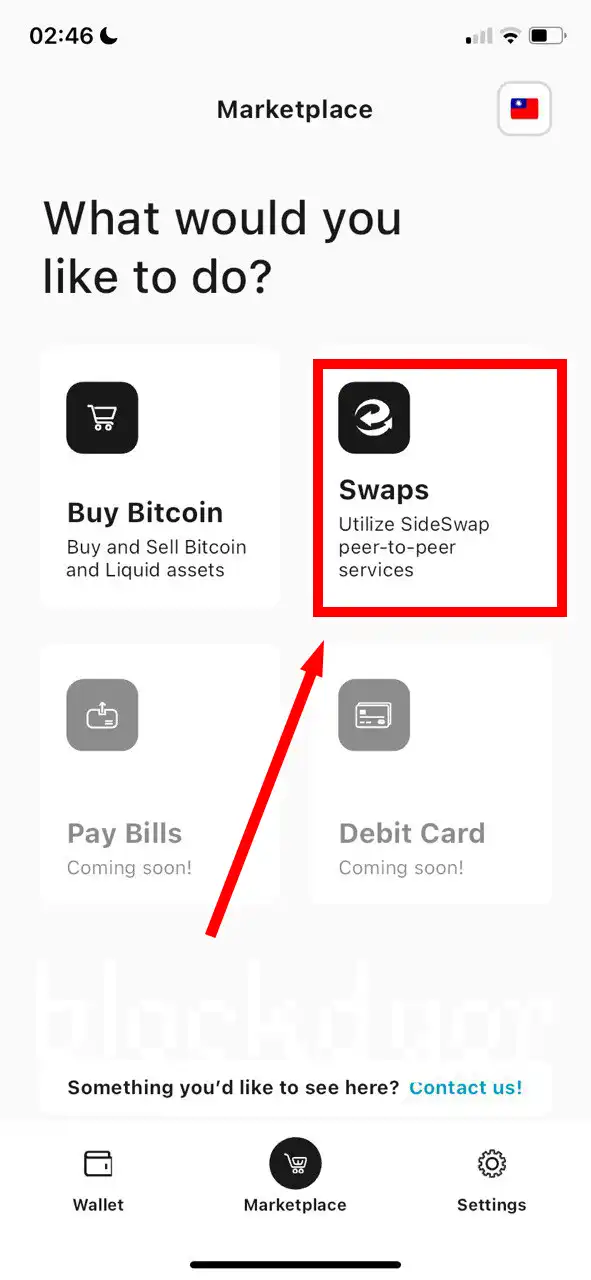
Navigate to the marketplace, where you'll encounter various functions. Choose the Swaps icon to proceed.
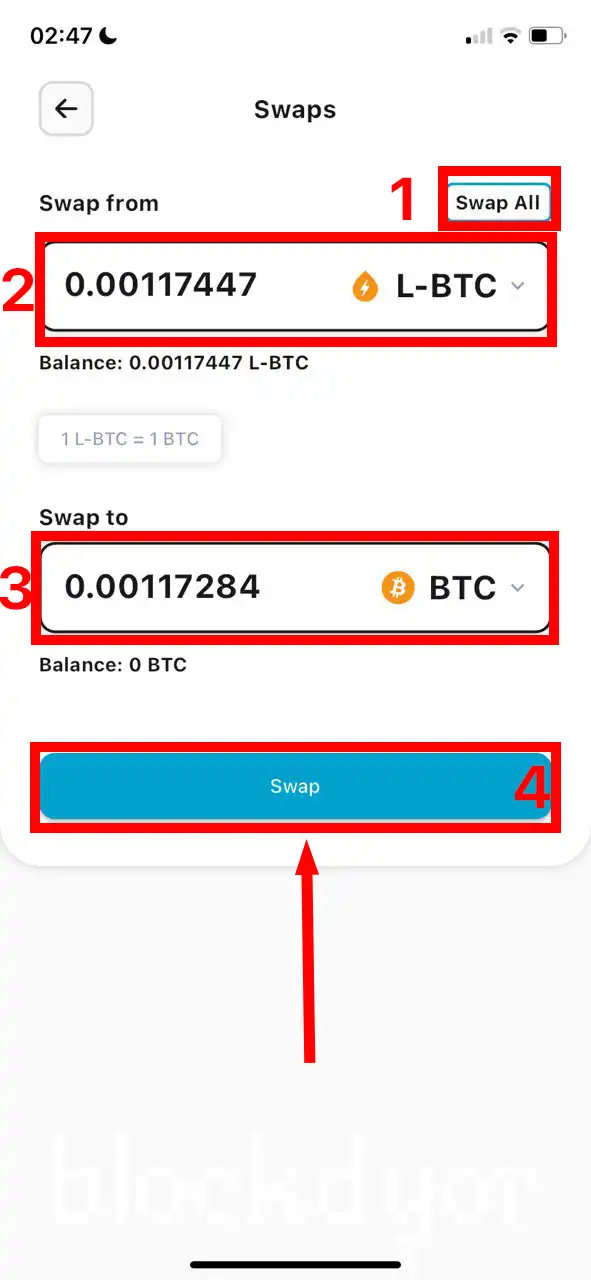
At the top, you have the option to pick a single asset for swapping (2), or you can simply tap on "Swap all" (1) to select all your assets. In the second field (3), you can choose the asset to swap to, with options such as Bitcoin (BTC), Liquid Bitcoin, Lightning Network Bitcoin, Tether USDt, and potentially more. Tap on the big "Swap" but to finally swap the assets (4).
Aqua Wallet Fees
Aqua isn't just a non-custodial, but as we've been able to see, it's also a solution to swap assets. So what are the fees with this particular solution and for the other functions? Some fees are available on the website of the wallet, but down here you can have a more complete view.
Bitcoin Fees
For transactions on the Bitcoin network within Aqua Wallet, fees operate similarly to Bitcoin itself. Under normal conditions, the fee starts at around 1 satoshi/vbyte. However, it's essential to note that current mempool congestion may result in higher fees.
Bitcoin network fees are influenced by network demand, and users should be aware that during periods of increased congestion, transaction fees may be higher to prioritize transaction processing.
| Transaction Type | Fee Calculation | Responsibility |
|---|---|---|
| Sending | Starts at around 1 satoshi/vbyte, subject to network congestion | Sender |
| Receiving | No fees for receiving transactions | Sender |
Lightning Fees
The minimum initial receiving amount stands at 1,000 SAT, accompanied by a service fee of 428 sats, which equates to a few cents.
| Minimum Initial Receiving Amount | Service Fee (Sats) | Approximate Fee (USD) |
|---|---|---|
| 1,000 SAT | 428 | $0.18 |
Liquid Fees
Liquid Network transactions incur fees paid in Liquid Bitcoin (L-BTC), functioning similarly to Bitcoin's transaction fees. Senders bear the responsibility for fees, always paid in L-BTC. The recipient doesn't need to hold L-BTC for transaction receipt.
Transaction fees on Liquid aim to prevent Denial of Service attacks, ensuring network stability. Collected fees are directed to a wallet controlled by Blockstream, covering Bitcoin mainchain fees and managing the Liquid Federation's mainchain BTC wallet.
Fees are determined by a market mechanism, with higher fees prioritizing faster transaction inclusion. The lowest Liquid transaction fee is presently 0.1 satoshi/vbyte, ensuring prompt confirmation. Liquid's transaction capacity is faster than Bitcoin's.
| Transaction Type | Fee Currency | Fee Calculation | Responsibility |
|---|---|---|---|
| Sending | Native Currency | Starts from 0.1 satoshi/vbyte, calculated by the network based on conditions | Sender |
| Receiving | None | No fees for receiving transactions | Sender |
Swap Fees
I encountered limited information about the swap service on the Aqua website. However, when attempting to swap L-BTC to BTC (Peg Out), I observed a reduction of around 0.12% in the received BTC.
This deduction seems indicative of the associated fees, and it closely aligns with the fees specified on the Sideswap website. Sideswap is the integrated tool in Aqua for such transactions. I anticipate a similar fee structure for pegging in BTC to L-BTC, reflecting the reciprocity of the swapping process.
| Swap Direction | Approximate Fee |
|---|---|
| BTC to L-BTC (Peg In) | ~0.10% |
| L-BTC to BTC (Peg Out) | ~0.10% |
Aqua integrates the Sideswap APIs, with a 0.10% swap fee alongside network fees. Notably, larger amounts of transactions tend to approach the 0.10% fee mark.
For substantial transactions, alternative platforms such as TDEX Wallet (BTC to L-BTC with network fees only) or exchanges supporting Liquid like Bitfinex, BTSE, and BTCTurk Pro offer distinct approaches.
These platforms enable swaps at a 1.0% rate with no additional fee on Bitfinex. While other exchanges may impose a withdrawal fee, the overall cost becomes more economical for larger BTC amounts.
Design & UX
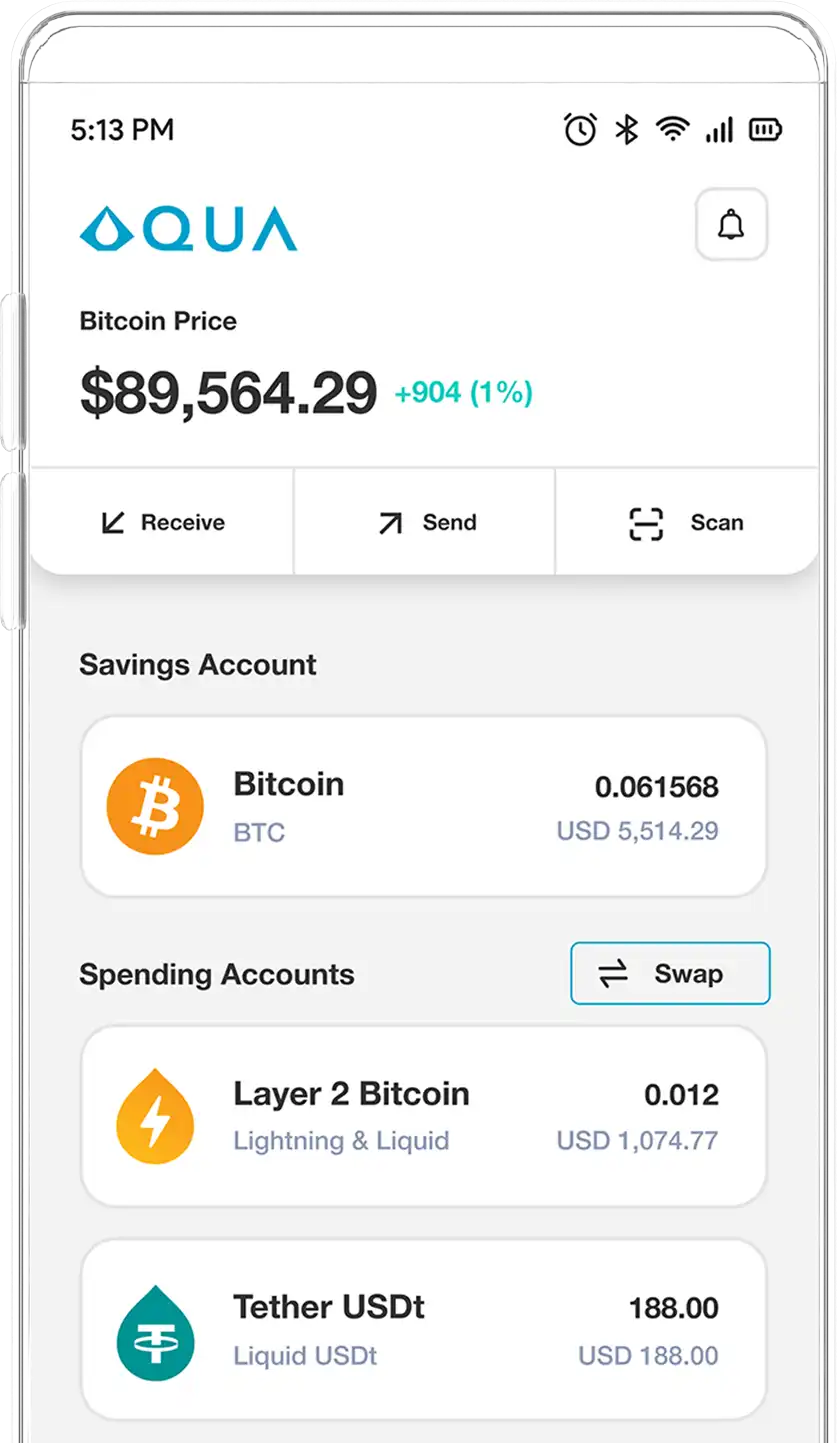
In a landscape where many software wallets tend to be complex and challenging to navigate, Aqua Wallet adopts a refreshingly straightforward approach.
It appears to be designed with the overarching goal of achieving mass adoption, featuring minimal functions and an exceptionally polished user interface. However, given that we are in the early stages, the app's potential seems incredibly promising, making it premature to pass a final judgment.
Connectivity
The connectivity of Aqua is confined to the features within the app itself. Unlike some other wallets, Aqua doesn't allow connection with TOR or even to your personal node, but it does offer the option to choose a block explorer.
While this may seem somewhat limited, it aligns with the app's philosophy of simplicity rather than laziness. For users seeking more connectivity and customization options, alternatives like Green Wallet by Blockstream might be a more suitable choice.
Advanced Features
The ability to effortlessly swap assets with just one tap is truly commendable and serves as a standout feature. Additionally, upcoming functions such as bill payments and debit card usage add further versatility. The option to Buy Bitcoin is also available, but upon exploration, I found the associated fees to be relatively high.
Personally, my preferred choice for purchasing Bitcoin is Kraken, given its remarkably low fees (0.26% taker/0.16% maker) and a Blockdyor Score of 62 out of 100. Kraken stands out as one of the top KYC exchanges we have reviewed so far, offering withdrawals on the main chain, or with the Lightning Network with minimal fees.
👉 Click here to open an account on Kraken and get started in minutes with as little as $10.
Warranty
The warranty of Aqua is explicitly outlined in the terms, emphasizing that all AQUA services, including the provided Wallet, are offered on an "as is" and "as available" basis.
This means that there is no representation or warranty, whether express or implied, regarding the services provided. The disclaimer extends to implied warranties of title, merchantability, fitness for a particular purpose, and non-infringement.
Security & Privacy
Although AQUA Wallet is a software wallet and may not offer the same level of security as an air-gapped hardware wallet, which keeps keys perpetually offline, it boasts notable features. One particularly commendable aspect is that Aqua Wallet is entirely open source.
Code Openness & Reproducibility
AQUA Wallet software is hosted on GitHub, and is released under the permissive MIT License.
While embracing open-source principles, the AQUA Wallet's Marketplace feature remains proprietary under JAN3. This strategic decision is rooted in the unique business integrations within the Marketplace, leaving other functionalities of AQUA unaffected.
Seed Generation
An essential aspect of AQUA is the Green Development Kit (GDK), a SideSwap-maintained fork originating from Blockstream's GDK. Responsible for critical functionalities like seed creation, wallet restoration, and transaction signing.
AQUA Wallet Review: Supported Coins

AQUA extends beyond Bitcoin, Liquid, and Lightning, offering a diverse range of assets. Let's explore them:
- Bitcoin (BTC): The pioneer cryptocurrency, on the main chain. A timeless classic, providing unparalleled security for storing Bitcoin.
- Tether USDT (Liquid USDT): A stablecoin tethered to the Liquid Network, ensuring stability and efficiency in transactions.
- Liquid Bitcoin (L-BTC): Despite criticism, it remains a robust solution during high-fee periods. Aqua favors it, swiftly converting Lightning Bitcoin to Liquid upon reception.
- Lightning Bitcoin (BTC): Displayed in sats, instantly converted to Liquid for simplicity. Users can generate invoices and send Lightning Bitcoin with seamless integration through Boltz.
- INF (INF): The official game currency of Infinite Fleet, issued on the Liquid Network, contributing to the gaming ecosystem.
- JPY Stablecoin (JPYS): A Japanese Yen stablecoin pegged 1:1 to JPY, legally recognized as a Prepaid Payment Instrument in Japan. It can be atomically swapped for L-BTC, maintaining a 1:1 peg to Bitcoin on the mainnet.
- PEGx EURx (EURx): EURx, a stablecoin issued by PEGx, a subsidiary of SideSwap, adding diversity to the stablecoin lineup.
- Tether USDt (Ethereum): Tether Dollar on the Ethereum Network, a widely used stablecoin.
- Tether USDt (Tron): Tether Dollar on the Tron Network, known for its lower gas fees compared to Ethereum, enhancing accessibility.
AQUA goes beyond the confines of the Bitcoin ecosystem, actively seeking to engage users with diverse preferences through its integration with the USDT stablecoin on the Tron and Ethereum networks.
This approach reflects its originality and inclusivity, catering to a broader audience beyond the Bitcoin-centric user base.
AQUA Wallet Alternatives
AQUA Wallet stands out as an excellent choice for straightforward self-custody, serving as a versatile and reliable daily driver. However, for users seeking more advanced features, I've curated a selection of alternative solutions:
- Blockstream Green: This software wallet, developed by Blockstream, supports BTC, Liquid, Lightning, and stablecoins. It offers advanced features such as the ability to connect to your own node backend and interface with hardware wallets like the Blockstream Jade.
- SideSwap: SideSwap presents itself as a desktop and mobile application specifically designed for peer-to-peer asset trading and self-custody of assets issued on the Liquid Network. Tailored for users with more advanced needs, it provides a robust solution for managing and swapping digital assets.
Pros & Cons of AQUA Wallet
AQUA boasts significant strengths in its simplicity, cost-effectiveness, and a groundbreaking approach that positions it as a superapp primed for widespread Bitcoin adoption.
The integration of Bitcoin with the main chain, Lightning, and Liquid in such a seamless manner makes it a potential go-to choice for daily use in the future. While its innovative features shine, the app currently lacks some advanced functionalities, likely a result of its relatively recent introduction. Regular updates could address this limitation, and I'll reassess as the app evolves.
| Pros | Cons |
|---|---|
| ✅ Easy to use | ❌ No desktop or PWA |
| ✅ Low fees | ❌ Cannot connect to personal node |
| ✅ No KYC | ❌ No hardware wallet integration |
| ✅ Open Source | ❌ No multisig |
Is Aqua Wallet Right For You?
Whether you're a beginner, intermediate, or advanced user, AQUA is likely to appeal to you. However, the most seasoned users might express reservations about the instant conversion of Lightning Network Bitcoin to Liquid Bitcoin. This design choice is primarily aimed at eliminating the complexities associated with managing channels in a Lightning wallet.
Despite this minor tradeoff and a handful of other features that are yet to be incorporated, I believe AQUA has already positioned itself as one of the top choices for those inclined towards a Bitcoin-centric, daily driver, wallet.
Bottom Line
AQUA Wallet emerges as a game-changer in the realm of Bitcoin wallets, offering a seamless blend of simplicity and functionality. Its innovative integration with the main BTC chain, Lightning, and Liquid not only sets it apart but also positions it as a potent tool for widespread Bitcoin adoption.
While the app caters well to users across different experience levels, advanced users might find minor trade-offs, such as the instant conversion of Lightning Network Bitcoin to Liquid Bitcoin.
Nonetheless, Aqua's commitment to user-friendly design and its potential for regular updates make it a strong contender for those seeking a reliable and easy-to-use non-custodial wallet, pushing the boundaries of financial empowerment in the Bitcoin space.

Aqua Wallet Evaluation
Achieving a blockdyor score of 61 out of 100, Aqua Wallet earns a well-deserved 4-star rating, positioning itself among the top-performing software wallets in our reviews to date.
Security: Aqua Wallet prioritizes security with its open-source nature, allowing users to verify the code for transparency. However, being a software wallet connected to the internet implies a level of vulnerability.
User-friendliness: Aqua Wallet is designed to be user-friendly, offering a seamless experience for both beginners and experienced users. The interface is intuitive, and the integration of various Bitcoin layers simplifies transactions.
Compatibility: Aqua Wallet stands out with its compatibility, supporting both Android and iOS devices. The inclusion of various Bitcoin layers ensures flexibility in transactions, and the wallet's usability extends to different networks.
Reputation: Aqua Wallet has gained recognition within the Bitcoin community for its innovative approach to integrating Bitcoin layers. User feedback and reviews indicate a positive reception, contributing to its reputable status.
Cost: Aqua Wallet is free of charge and maintains low fees for transactions, aligning with its goal of providing an affordable solution.

